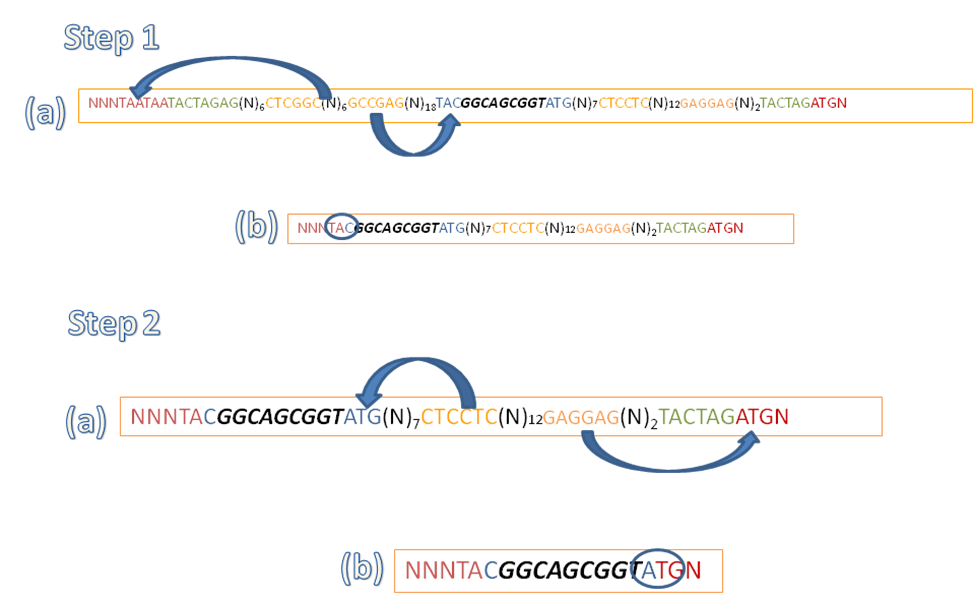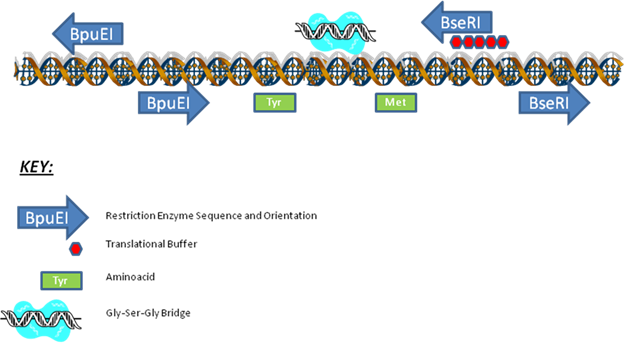Team:BCCS-Bristol/Bioscaffold/BCCS Bioscaffold
From 2009.igem.org
iGEM 2009
Contents |
BCCS Bioscaffold-Linker
For the purposes of our project we had to construct protein fusions comprising of a carrier and a cargo and as a result we had to deal with this fusion problem in some way. This led to us to design and create a new type of [http://partsregistry.org/Part:BBa_K259002 Bioscaffold] which would keep the basic concept of bioscaffold the same but offer more flexibility in terms of protein fusions.
Bioscaffold Features
Our bioscaffold is placed between two coding biobricks and contains restriction sites of atypical Type II restriction enzymes like assembly standard 15. It has a restriction site of BpuEI (Type IIS) on the left hand side and BseRI (Type IIB) on the right hand side (both are 6 cutters). The bioscaffold is compatible with assembly standards 10, 21, 23 and 25 and is very versatile because it can be used with almost all biobricks.
Bioscaffold Application
The bioscaffold application is quite simple and easy. First of all the bioscaffold must be ligated between the two protein encoding sequences and then treated with the restriction enzymes. Essentially it comprises of two steps:
Step 1: The left hand side of the bioscaffold has two BpuEI sites incorporated in inverse orientation. This allows upon cleavage with BpuEI the removal of the stop codons from the upstream part and a small sequence from the Bioscaffold. Complementary overhangs are created between the partly cleaved stop codon and the Bioscaffold sequence, which when ligated together convert the stop codon to a Tyrosine amino acid
Step 2: Two BseRI sites are incorporated in the right hand side, again in inverse orientation. On BseRI cleavage both upstream and downstream DNA sequences of the BseRI sites will be removed causing the collapse of the Bioscaffold and creating complementary ends between the Bioscaffold and the downstream coding gene. Upon ligation these ends will give a Methionine start codon which leads to a scarless downstream fusion.
In the middle of the Bioscaffold sequence there is a Gly-Ser-Gly linker bridge which is maintained if the application of the Bioscaffold is done in the correct order as outlined in the two paragraphs above. In case the Bioscaffold has failed to perform as expected the translational buffer will disallow the translational machinery of the cell to encode for the downstream protein.

Bioscaffold Advantages
All stop codons are removed by the action of these restriction enzymes and thus will allow the expression of all the protein partners in the fusion. Also the methionine start codon of downstream gene is maintained and hence it will be transcripted correctly. An important advantage of bioscaffold is the Gly-Ser-Gly linker that is added between the two genes after the restriction digest which provides flexibility for the correct folding of proteins in the fusion into their native 3D conformations. Furthermore the reading frame of both proteins remains unchanged maintaining their primary structure intact. BpuEI and BseRI restriction sites are not present in pSB2K3 vector so biobrick fusions can be safely carried out on this vector. Last but not least the bioscaffold is biobrick-compatible making it very useful to synthetic biologists.
BBF RFC44
All RFC's can be found at the Biobricks foundation page here.
The BCCS Bioscaffold has been submitted as BBF RFC44.
Download a copy of RFC44 that describes in detail the practices that implicate using the Bioscaffold to achieve protein fusions.
 "
"
